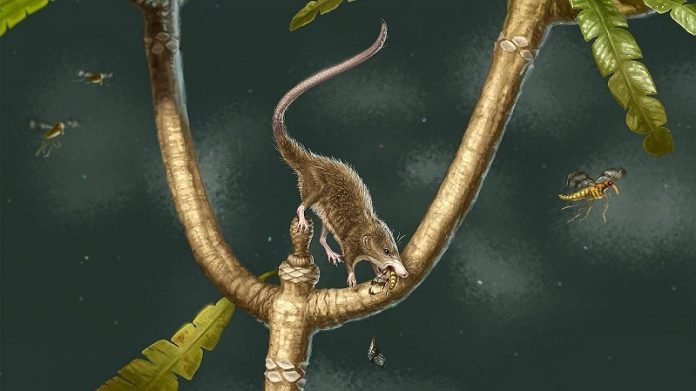
Researchers have found the earliest known evidence of a mammal predecessor with sophisticated bones at the back of the neck that allowed for swallowing food in the same way that modern mammals do.
Microdocodon gracilis, a 165-million-year-old fossil found in China, offers the best example yet of how mammals stopped gulping down their food whole and started chewing and swallowing in smaller bites.
The tiny, shrew-like animal offers new insights into a key function that separates mammals from other vertebrates.
The discovery was announced July 18 in the journal Science.
Yale’s Bhart-Anjan Bhullar is co-lead author of the new study, which also includes researchers at University of Chicago, University of Bonn, and Paleontological Museum of Liaoning in China.
Earlier this year, Bhullar’s lab published a paper in the journal Nature that described the way the first mammals likely chewed their food.
“We mammals are quick-witted and surefooted compared to our cold-blooded ancestors. Our inner furnaces burn hot and fast, and they are always hungry for fuel,” Bhullar said.
“We previously described how tiny, furry, near-mammals like Microdocodon were able to chew in the unique, efficient mammalian way, but this remarkable new specimen shows that the second part of the mammalian food-processing chain — powered swallowing — had also arisen prior to the proliferation of modern mammalian species.
Equipped to chew thoroughly and swallow quickly, Microdocodon would have been a swift, smart, warm-blooded creature, able to thrive in a world filled with formidable reptilian predators and competitors.”
Microdocodon had tiny hyoid bones that linked the back of its mouth to openings in the esophagus and the larynx.
Like modern mammals, their hyoid bones were jointed and arranged in a “U” shape. These bones were flexible enough to allow the throat muscles to transport and swallow smaller chunks of food and water.
Other vertebrates have a wide throat and hyoid bones that are rod-like and not jointed. That architecture only allows them to swallow food whole or in large chunks.
“Mammals have become so diverse today through the evolution of diverse ways to chew their food, whether it is insects, worms, meat, or plants.
But no matter how differently mammals can chew, they all have to swallow in the same way,” said Zhe-Xi Luo of the University of Chicago, senior author of the study.
“Essentially, the specialized way for mammals to chew and then swallow is all made possible by the agile hyoid bones at the back of the throat.”
Added Bhullar, “Hyoids and ear bones are all derivatives of the primordial vertebrate mouth and gill skeleton, with which our earliest fishlike ancestors fed and respired.
The jointed, mobile hyoid of Microdocodon coexists with an archaic middle ear — still attached to the lower jaw. Therefore, the building of the modern mammal entailed serial repurposing of a truly ancient system.”
Written by Jim Shelton.



